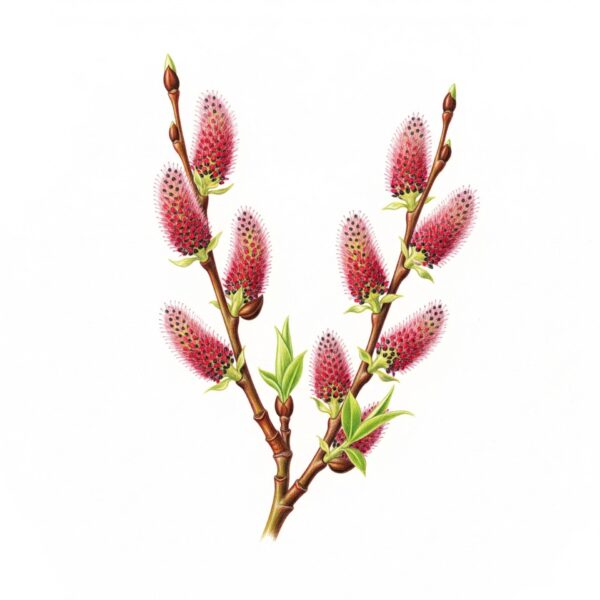Key Characteristics:
- Catkins: The most prominent feature of the ‘Mount Aso’ willow are its furry, rosy-pink catkins . These appear in abundance on bare stems in late winter, before the leaves emerge, and are an eye-catching source of colour and texture in the garden when little else is in bloom. They are a male cultivar, meaning they are the pollen-producing catkins.
- Foliage: After the catkins have finished flowering, the shrub produces its leaves. The leaves are a fresh blue-green on the top side, with a silvery, silky underside. The foliage remains attractive throughout the spring and summer, providing a pleasant backdrop for other flowering plants.
- Growth Habit: ‘Mount Aso’ is a bushy, multi-stemmed shrub grown as a standard with an upright, wide-spreading habit. It can reach a mature height and spread of 1.5 to 3 meters (5 to 10 feet), though it can be kept smaller with regular pruning. It is a moderate to vigorous grower.
- Origin: This cultivar is native to Japan, Korea, and China, and was specifically selected by a Japanese cut-flower breeder named Dr. Tsuneshige Rokujo. Its name is derived from Mount Aso, a large active volcano in Japan where it was first found.
Growing Conditions and Care:
- Sunlight: This willow thrives in full sun, but it can also tolerate partial shade.
- Soil: It is a hardy and adaptable plant that can grow in various soil types, including sand, loam, and clay. However, it prefers deep, moist but well-drained soil. It is also tolerant of wetter locations, making it a good choice for problem spots in a garden. It can handle a range of pH levels, from acid to alkaline.
- Pruning: For the best display of catkins, it’s recommended to prune the shrub every two to three years in late winter or early spring before the leaves emerge. Hard pruning (coppicing) encourages the production of new, vigorous stems with a more prolific catkin show.
Landscaping and Uses:
The ‘Mount Aso’ willow is highly versatile in a garden setting.
- Specimen Plant: Its striking winter interest makes it an excellent focal point in a garden border or a mixed shrub bed.
- Cut Flowers: Due to its origin with a cut-flower breeder, the catkin-laden stems are highly sought after for floral arrangements and bouquets. They can be cut and “forced” to bloom indoors as early as January.
- Wildlife: The plant is known to be a great source of nectar and pollen for pollinating insects, such as bees. It is also deer and rabbit resistant.
- Other Uses: Its tolerance for various conditions makes it suitable for coastal gardens and city gardens as it is salt and pollution tolerant. It can also be used as a screen or in mass plantings on larger properties, particularly in damp areas, to provide habitat for wildlife.

